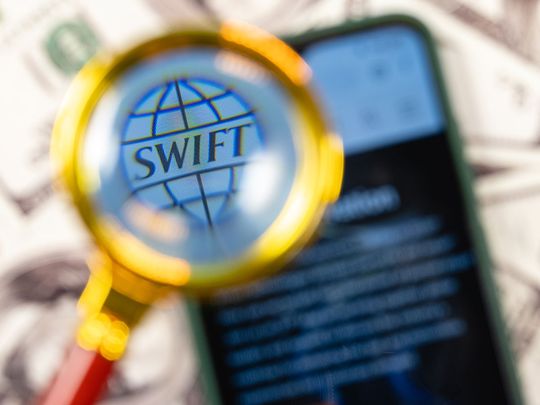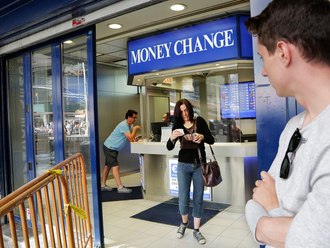
Dubai: Do you keep seeing the word ‘SWIFT’ whenever you bank or transact money across countries? It is simply a central bank-governed network, which banks globally use to communicate with each other securely, mainly to give instructions for transferring funds between accounts.
Why is this relevant now? This global bank messaging network said last week that it will plan a new platform within the next two years to connect the central bank digital currencies (CBDCs), now in development, to the existing finance system.
Also, SWIFT's latest trial took six months and involved 38 central banks, commercial banks and platforms, and had been one of the largest global collaborations on CBDCs and ‘tokenised’ assets to date, the latest Reuters report revealed. But will this eventually change the way we bank?
“With 90 per cent of the world's central banks now exploring digital versions of their currencies and given SWIFT's key role in global banking, the latest move would be one of the most significant yet for the nascent CBDC ecosystem,” explained Abbud Sharif, a banking industry analyst based in Dubai.
“Research also shows that they could be used in highly complex trade or foreign currency exchanges between banks worldwide, potentially giving rise to automating and speeding up such transactions, which in turn lowers the costs of the processes and savings passed down to users or customers.”
CBDCs are similar to cryptocurrencies, except that their value is fixed by the central bank and equivalent to the country's national currency. While a new form of electronic money, unlike cryptocurrencies, they are issued by central banks of countries.
In other words, these central bank-issued digital currencies are simply digital tokens, similar to cryptocurrency, pegged to the value of a country's currency. But they are not a form of cryptocurrency.
Why CBDCs are not as risky as cryptocurrencies
“Although the idea for CBDCs came from cryptocurrencies, they are two very different types of digital currencies. The key difference between CBDCs and cryptocurrency is centralisation,” explained Brian Deshell, a UAE-based cryptocurrency trader and analyst.
“Centralisation is simply the control of an activity under a single authority. A cryptocurrency is a decentralised digital currency, meaning there's no central party that controls it. With CBDCs, the central control of authority lies with the issuing country’s central bank.”
CBDCs are by definition most similar to what is known as Stablecoins, which are cryptocurrencies that are pegged to national currencies and attempt to maintain the same value. The main difference is that the world's governments issue CBDCs, while Stablecoins are issued privately.
CBDC is managed on a digital ledger (which can be a block chain or not), expediting and increasing the security of payments between banks, institutions, and individuals – which is the use case for SWIFT in this latest development.
In case of cryptocurrency, transactions are sent and received through wallet addresses, and it's possible to retain some degree of anonymity. Certain types of cryptocurrency are even thought to be untraceable. With a CBDC, the central bank will have a record of users and their transactions.
130 countries and counting
130 countries around the world are researching or developing CBDCs, and they're at various stages of the process. As of mid-2023, 11 countries adopted a CBDC, with an additional 53 being in advanced planning stages and 46 researching the topic, according to e-research platform Statista.
In 2020, a group of seven central banks including the US, Europe, Japan, Switzerland, Canada, Sweden, and England, indicated an intention to assess the feasibility of implementing publicly available CBDCs. The most recent addition to the countries issuing a CDBC is Jamaica.
Other countries are beginning to implement CBDCs including China and Russia as well as a host of smaller nations including South Africa, Uruguay, Barbados, Switzerland, Thailand and Iran. In 2022, the UAE became the latest regulator to express an interest in issuing a CBDC.
“The public reasoning is often more guarded. Centralised oversight of the movement of currency could put an end to a lot of fraud. Identifiable digital currency is also hard to steal. Moreover, a currency that can move without sorting banks and clearing houses involves far lower costs.
“This is especially true for corporations that conduct thousands of transactions per day. Since CBDCs could affect the crypto market, understanding them is important if you're investing in cryptocurrency.”
How can you benefit from SWIFT’s global platform for CBDCs?
Industry experts worldwide widely deem central bank money as the “safest form of money available”. A CBDC could also lead to transactions that are much faster, cheaper, which benefits everyone involved. In countries creating CBDCs, you can get quicker access to central bank funds.
“When it comes to benefits, a CBDC can be classified into two - 'Retail' CBDC, would be used like a digital extension of cash by all people and companies, and a 'Wholesale' CBDC, which could be used only by permitted institutions as a settlement asset in the interbank market,” added Deshell.
“Retail CBDCs are issued to the general public. Under this model, consumers are able to own a CBDC in a wallet or account and use it for payments. This type of CBDC would serve as a public digital banking option that anyone can use.”
Bottom line
So will SWIFT’s global platform for CBDCs eventually change the way we bank? This, experts agree, boils down to whether or not CBDCs will be deemed as the future of money. According to analysts at global accounting giant PricewaterhouseCoopers (PwC): "It is highly probable. The future of money will be a mix of centralised, decentralised, account-based and token-based with CBDCs, stablecoins and crypto currencies co-existing alongside traditional digital and physical currencies."
Sharif and Deshell too agreed that CBDC could “much likely” be the future of payments. “It will be interesting to see how the market evolves as more central banks begin to explore and adopt this technology,” added Sharif. “CBDCs have the potential to revolutionise the financial world. As a digital form of a country's currency regulated by its central bank, they will be benefitted by a technology that allows central banks to channel payments directly to households. So they not only potentially benefit economies, they offer everyone involved a safe and low-cost alternative to cash.”












